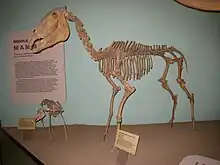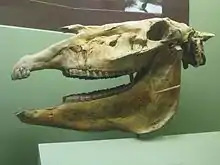| Hagerman horse Temporal range: Pliocene-Early Pleistocene | |
|---|---|
 | |
| Mounted skeleton of a Hagerman horse | |
| Scientific classification | |
| Domain: | Eukaryota |
| Kingdom: | Animalia |
| Phylum: | Chordata |
| Class: | Mammalia |
| Order: | Perissodactyla |
| Family: | Equidae |
| Genus: | Equus |
| Subgenus: | Dolichohippus |
| Species: | †E. simplicidens |
| Binomial name | |
| †Equus simplicidens | |
| Synonyms | |
| |
Equus simplicidens, sometimes known as the Hagerman horse or the American Zebra is an extinct species of equine native to North America during the Pliocene and Early Pleistocene. It is one of the oldest and most primitive members of the genus Equus. Abundant remains of it were discovered in 1928 in Hagerman, Idaho. It is the state fossil of Idaho.[3]
Classification

The Hagerman horse was given the scientific name of Plesippus shoshonensis in 1930 by a Smithsonian paleontologist named James W. Gidley[2] who led the initial excavations at Hagerman that same year.
However further study by other paleontologists determined that fossils closely resembled fossils of a primitive horse from Texas named Equus simplicidens, named by paleontologist Edward Drinker Cope in 1892. Because of this similarity, the two forms were interpreted[4] to be the same species, and since the name Equus simplicidens was the older name, it was retained following the taxonomic Principle of Priority. The Hagerman fossils represent some of the oldest widely accepted remains of the genus Equus.
Discovery
A cattle rancher named Elmer Cook discovered some fossil bones on this land in Hagerman, Idaho. In 1928, he showed them to Dr. H. T. Stearns of the U.S. Geological Survey who then passed them on to Dr. James W. Gidley at the Smithsonian Institution. Identified as bones belonging to an extinct horse, the area where the fossils were discovered, called the Hagerman Horse Quarry, was excavated and three tons of specimens were sent back to the Smithsonian in Washington, D.C.
Excavation of the fossils continued into the early 1930s. The Hagerman Horse Quarry floor grew to 5,000 square feet (460 m2) with a backwall 45 feet (14 m) high. Ultimately five nearly complete skeletons, more than 100 skulls, and forty-eight lower jaws as well as numerous isolated bones were found. Some paleontologists believed that such a large amount of fossils found in one location was because of the quarry area being a watering hole at one point. The waterhole could have been where the bones of the Hagerman horses accumulated as injured, old, and ill animals, drawn to water, died there. Other paleontologists think that an entire herd of these animals drowned attempting to ford a flooded river and were swept away in the current and ended up buried in the soft sand at the bottom.
Taxonomy
The genus placement of the species is controversial, with some authors choosing to place the species in Plesippus instead.[5] A 2019 phylogenetic analysis found it to be more closely related to living Equus than to Hippidion or Dinohippus, but outside the group containing all living equines.[6] Some authors have argued for a close relationship of Equus simplicidens with living zebras to the exclusion of other living equines, but these claims have been considered equivocal by others, who note that many "stenonine horses" from Eurasia exhibit similarities to zebras.[7]
See also
References
- ↑ Cope, E. D. (1892). "A Contribution to the Vertebrate Paleontology of Texas". Proceedings of the American Philosophical Society. 30 (137): 124–125. JSTOR 983215.
- 1 2 J.W. Gidley (1930) A new Pliocene horse from Idaho. Journal of Mammalogy 11: 300-303 JSTOR 1374150 doi:10.2307/1374150
- ↑ Idaho: Equus simplicidens (state fossil). StateFossils.com
- ↑ D.E. Savage (1951) late Cenozoic vertebrates of the San Francisco Bay region. University of California Bulletin of the Department of Geological Sciences 28: 215-314
- ↑ Orlando, Ludovic; Ginolhac, Aurélien; Zhang, Guojie; Froese, Duane; Albrechtsen, Anders; Stiller, Mathias; Schubert, Mikkel; Cappellini, Enrico; Petersen, Bent; Moltke, Ida; Johnson, Philip L. F.; Fumagalli, Matteo; Vilstrup, Julia T.; Raghavan, Maanasa; Korneliussen, Thorfinn (2013-07-04). "Recalibrating Equus evolution using the genome sequence of an early Middle Pleistocene horse". Nature. 499 (7456): 74–78. Bibcode:2013Natur.499...74O. doi:10.1038/nature12323. ISSN 0028-0836. PMID 23803765. S2CID 4318227.
- ↑ Cirilli, Omar; Pandolfi, Luca; Rook, Lorenzo; Bernor, Raymond L. (2021-05-12). "Evolution of Old World Equus and origin of the zebra-ass clade". Scientific Reports. 11 (1): 10156. Bibcode:2021NatSR..1110156C. doi:10.1038/s41598-021-89440-9. ISSN 2045-2322. PMC 8114910. PMID 33980921.
- ↑ O’Brien, Kaedan; Tryon, Christian A.; Blegen, Nick; Kimeu, Boniface; Rowan, John; Faith, J. Tyler (March 2021). "First appearance of Grévy's zebra (Equus grevyi), from the Middle Pleistocene Kapthurin Formation, Kenya, sheds light on the evolution and paleoecology of large zebras". Quaternary Science Reviews. 256: 106835. Bibcode:2021QSRv..25606835O. doi:10.1016/j.quascirev.2021.106835. S2CID 233638447.
Further reading
- Boss, N. H. "Explorations for Fossil Horses in Idaho". Explorations and Field Work of the Smithsonian Institution in 1931. 1932.
- Gazin, C. L. '" Study of the Fossil Horse Remains from the Upper Pliocene of Idaho. Proceedings from the United States National Museum 83(2,985): 281-320. 1936.
- MacFadden, Bruce J. Fossil Horses: Systematics, Paleobiology and Evolution of the Family Equidae. Cambridge Univ. Press, 1992.
- McDonald, H. Gregory. "More than Just Horses", Rocks and Minerals, September/October 1993. Vol. 68:322-326.
- Willoughby, David P. The Empire of Equus. A.S. Barnes and Co., 1974
- Castle Rock Ranch – Hagerman Horse Quarry Land Exchange Environmental Assessment